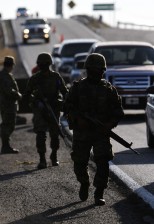Police catch suspect in 75 drug cartel killings

DRUG WAR CONTINUES Mexican army soldiers stand guard at a check point on the outskirts of Culiacan, northern Mexico, Sunday, Jan. 29, 2012. Nationwide, some 47,515 drug-related killings occurred from December 2006, when President Felipe Calderon deployed thousands of troops to drug hot spots, through September 2011, the Attorney General's Office said Wednesday, Jan. 11, 2012. (AP Photo/Marco Ugarte)
MONTERREY, Mexico— Police in northern Mexico have captured an alleged member of the Zetas drug gang who confessed to killing at least 75 people, including many who were pulled off buses, authorities said Monday.
Enrique Elizondo Flores told investigators 36 of his victims were bus passengers traveling through the town of Cerralvo, near the border with Texas, said Nuevo Leon state security spokesman Jorge Domene.
Elizondo was detained Jan. 20 in the town of Salinas Victoria, but authorities delayed announcing his arrest so they could verify details of his confession, state Attorney General Adrian de la Garza said.
Domene said the 35-year-old suspect told investigators that he had been working in the area at least three years and that he was in charge of killing members of the rival Gulf drug cartel heading to the towns of Cerralvo and General Trevino.
Elizondo and other gunmen last January began pulling passengers off buses as they arrived at Cerralvo’s bus station, Domene said. They are among at least 92 bus passengers the Zetas are accused of killing in three attacks in January and March 2011. Many the victims were originally from the central state of Guanajuato and had arrived in Cerralvo from the border city of Reynosa, Domene said.
Article continues after this advertisementElizondo was known “for torturing, maiming and then killing his victims,” Domene said.
Article continues after this advertisementLast year, authorities in the neighboring state of Tamaulipas unearthed 193 bodies from clandestine graves in the town of San Fernando. Security forces said they were led to the site by members of the Zetas who confessed to kidnapping and killing bus passengers traveling through the area.
The motive for the bus abductions remains unclear. Prosecutors have suggested the gang may be forcefully recruiting people to work for it or trying to kill rivals they suspected were aboard the buses.
Northeastern Mexico has been engulfed by a turf battle between the Gulf Cartel and the Zetas since they split in 2010.
More than 47,000 people have been killed nationwide since President Felipe Calderon launched a crackdown against drug traffickers in December 2006.
Global Financial Integrity, a program of the Center for International Policy, a Washington-based think tank, said Monday that its analysis found that $872 billion in proceeds from crime, corruption and money-laundering had flowed out of Mexico in the four decades from 1970 to 2010.
In the border city of Ciudad Juarez, police officers killed three men and detained a fourth Monday after being attacked at a gas station, authorities said.
The officers were refueling their patrol cars at a gas station a few blocks from the Zaragoza border crossing into El Paso, Texas, when they were attacked, a police statement said. The officers returned fire, killing three assailants, and they also seized two assault rifles, two handguns and a hand grenade, it said.
Last week, messages signed by the New Juarez drug cartel and left in several parts of the city claimed Police Chief Julian Leyzaola is favoring a rival cartel. It said that one officer would be killed daily if their members continue to be arrested. Five police officers have been killed since.
Leyzaola was not immediately available to comment on Monday’s attack.
In a public appearance over the weekend, Mayor Hector Murguia said the recent string of attacks on law enforcement officers was a response from criminals affected by Leyzaola’s work.
“Go downtown, there are no more brothels where drugs used to be sold,” he said, referring to a police crackdown in downtown Juarez as part of the city’s efforts to combat crime.
As a safety measure, police officers are now required to leave precincts wearing street clothes and are allowed to take their guns home. The city also is considering plans to rent hotels to quarter all the police force.
In 2009, then Police Chief Roberto Orduna quit after several police officers were killed and their bodies dumped along with messages saying more officers would be killed unless he resigned.
Leyzaola is no stranger to threats. Shortly after he was hired in 2011, the body of a tortured man was left in a street with a message to Leyzaola that read, “This is your first gift.”
In April 2009, when he was police chief in western border city of Tijuana, drug traffickers took over police radio frequencies to say that if he didn’t quit, many police officers would die.
A few days after, seven officers were killed in separate but coordinated attacks. Drug traffickers took over the police radio frequencies again to say their threat had been carried out.
___
Associated Press writer Juan Carlos Llorca in El Paso, Texas, contributed to this report.